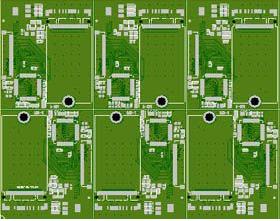Do you know the steps for PCB design? Let's talk about the main steps of PCB design in the editor of Komolong below! PCB design is mainly divided into seven steps. Let’s take a look at the seven steps!
1. Preliminary preparations. Including preparatory component library and reasoning diagram. Before PCB design, we must first prepare the logic diagram SCH component library and PCB component packaging library. The PCB component packaging library is preferably set up by the engineer according to the dimensions and materials of the selected device. In principle, the PC component package library is established first, and then the SCH component library is established. PCB component packaging library requirements are high, it will indirectly affect the installation of PCB; reason diagram SCH component library requirements are relatively loose, but we must pay attention to the pin attributes and the corresponding relationship with the PCB component packaging library.
2. PCB layout ideas. According to the once affirmed circuit board size and various machine positioning, draw the PCB board frame under the PCB design, and arrange the required connectors, buttons/switches, screw holes, assembly holes, etc. according to the positioning requirements. Filling considers and confirms the wiring area and non-wiring area (such as how large the screw hole is around the non-wiring area).

3. PCB structure design. The structural design is to place the components in the PCB frame according to the design requirements. Collect in the truth map-Import Netlist). After the collection table is imported, it will exist in the software background. After Placement manipulation, all devices can be called out and there is a flying line reminding connection between each pin. At this time, the device structure can be imagined. The PCB structure design is the first major process in the entire design process of the PCB. The larger the PCB board, the more black and white the structure can indirectly affect the difficulty of pre-wiring. The structural design relies on the circuit board designer's circuit skills and rich experience, which is a relatively elementary requirement for the circuit board designer. The junior circuit board designer has a shallow experience, and is suitable for small module structure design or PCB structure design with low overall board difficulty.
4. PCB wiring design. The PCB layout design is the most intensive process in all the PCB design, which indirectly affects the function of the PCB board. In the process of PCB design, there are generally three situations for wiring: First is the layout, which is the most basic entry requirement for PCB design; Second is the contentment of electrical functions, which is the standard for weighing whether a PCB board is qualified; After the wiring is laid out, adjust the wiring so that it can reach the best electrical function; whether it is neat and beautiful or chaotic, even if the electrical function is passed, it will bring great convenience to the early revision and optimization, testing and maintenance, and wiring requirements It's neat and tidy, and it can't be intertwined vertically and horizontally.
5. Wiring optimization and silk screen placement. "PCB design is an art with shortcomings". This is because PCB design must not only realize the design requirements of all aspects of hardware, but also consider the conflicts between individual needs. After the PCB layout optimization is completed, the need to stop the disposal, the important thing to deal with is the silk screen logo on the PCB surface. It is envisaged that the bottom silk screen characters need to be mirrored to avoid mixing with the top silk screen.
6. Collect DRC inspection and layout inspection. Quality control is the main component of the PCB design process. Common quality control methods include: design self-inspection, design mutual inspection, expert review meetings, special sampling, etc. Principle diagram and layout element diagram are the most basic design elements. Collecting DRC inspection and layout examination is to confirm the two input prerequisites of PCB design principle diagram netlist and layout element diagram. Special inspections include Valor inspections and DFM inspections. The content of these two departments is the PCB design and output back-end processing light drawing files.
7. PCB system board. Before the PCB is officially processed and made, the circuit board designer needs to directly communicate with the PE of the PCB processing board factory to answer the manufacturer's brief questions about the PCB board processing.